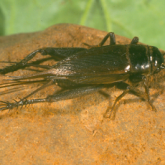Black field cricket

Black field cricket adult
© J. Wessels Queensland Government
Black field crickets feed on the leaves and stems of seedlings. In plague numbers they may reduce a stand to the extent that replanting is necessary.
Scientific name
Description
Winged adults:
- black or brown and up to 30mm long
- head and mouthparts are inclined downwards
- large hindlegs are modified for jumping.
Nymphs are similar in shape but are smaller, paler and wingless. Small nymphs may have a white band across their back.
Distribution and habitat
Widespread in Australia. Common in cracking soils.
Hosts
Many field crops, including most pulses and many pastures. They may damage cotton when present in plague numbers.
Damage
Most damage is caused either by crickets already in the area at planting, or by adults flying into crops.
- Crops can be attacked at any stage.
- Crops in heavier soils are at greatest risk.
- Adults and nymphs feed on leaves, stems and pods.
- At podding, adults chew into pods to reach the seeds.
In sunflower, crickets feed on seedlings, the back of flower heads, and maturing seeds.
Life cycle
Both adults and nymphs shelter during the day in cracks in the soil or under trash. They come out at night and feed on weeds, grasses or crops.
Monitoring and thresholds
Inspect crops at dusk when crickets are most active. Activity can also be monitored with light traps.
Take action if significant cricket populations are present.
Natural enemies
Natural control agents, including diseases, beneficial insects, and predatory birds, appear to have little effect..
Control
- Use insecticide-treated cracked-grain baits.
- Practice good farm hygiene as weedy fields prior to planting may encourage crickets.
Further information
- Black field cricket—Cesar PestNotes
- Registered chemicals database—Australian Pesticides and Veterinary Medicines Authority (APVMA)